Scottish Employer Perspectives Survey 2019: research report
Comprehensive research report outlining the results of a survey of employers in Scotland regarding their approach to recruitment and training.
5. People Development
Chapter Summary
Around seven in ten employers (70%) had provided any training (internal or external) for their staff in the 12 months preceding the survey, a decrease from the 73% seen in 2016. This decrease in overall training levels was concentrated on the smallest employers (those with just 2-4 staff).
More employers offered internal training (60%) than external (49%), with 39% having provided both. Employers that provide training (referred to throughout the chapter as “training employers”) predominantly use private training providers (65%), compared to just 19% using public providers (i.e. colleges and universities).
Three in ten (31%) of all employers had provided training for staff designed to lead to a vocational qualification. This equates to 44% of all training employers. This is a statistically significant increase on the proportion seen in 2016 (26% of all employers, 36% of training employers). Employers were positive about the impact vocational qualifications had had on their business, with 84% agreeing they could easily be adapted to business needs and 85% agreeing they lead to better business performance.
Around three in ten employers (29%) had experienced a skills or training issue in the last 12 months that required external information, advice or practical help. Of these, 76% had sought or received such advice.
Under half (44%) of employers who had provided training towards VQs had been somehow involved in the design of the delivery and/or content of the course. Similarly, 39% of employers who had provided external training had been involved in its design or influenced the content. Of those who were not involved with each, 18% said they would have liked to have been involved in the design of VQs and 17% said they would have liked to have been involved in the design of external training. The most common reason for not being involved was that they did not know they could or had not been given the opportunity, but many also said they felt it was too much time and effort to do so or that the provider was not open to their involvement.
Introduction
This chapter looks in detail at the employers that are providing training to staff and the types of training they offer. Specifically, it includes:
- Employer approaches to training: including provision of internal and external training, and the source of this training, in particular use of public and private training providers;
- Vocational Qualifications: whether the current offering is meeting employer needs, including: (a) the uptake of the qualifications; (b) employers’ views on their benefits and impacts; and (c) the reasons employers give for not using them;
- Sources of information, advice and support on skills and/or training related issues;
- Employers’ level of involvement with the design of their training courses: both for vocational qualifications and external training; and
- National Occupational Standards: including awareness and involvement with / use of.
Employer approaches to training
The Employer Perspectives Survey (EPS) identifies two categories of employer training:
- Internal training (training delivered directly by the organisation through its own staff); and
- External training (delivered through external organisations, such as commercial training providers, colleges, universities and other not-for-profit providers).
Separating training into internal and external provision in this way allows us to explore the way in which employers utilise public and private training provision and the extent to which each meets their needs.
Figure 5.1 illustrates how employers approach their training and the types of providers they use. Around seven in ten establishments (70%) had provided either internal or external training for their staff in the previous 12 months. More employers reported providing internal training (60%) than external (49%), with 39% providing both.
Figure 5.1: Nature and source of training offered by employers in last 12 months
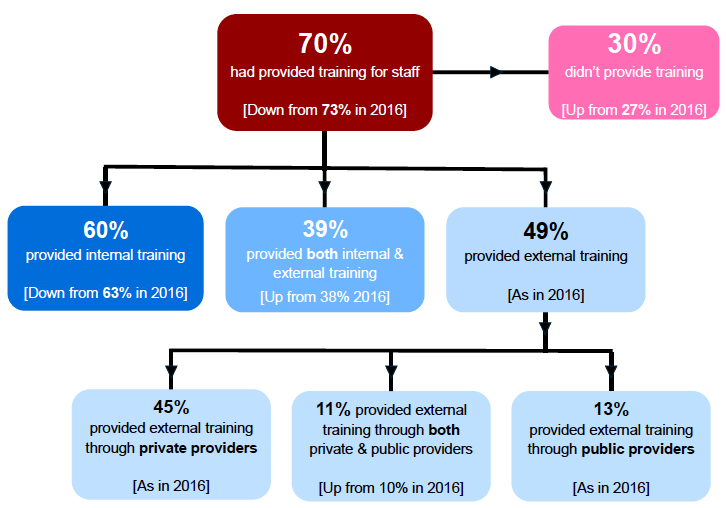
Base: all establishments (2,652)
The proportion of employers offering training has decreased by three percentage points since 2016, from 73% to 70%.[17] The decrease was driven by a decrease in training among the smallest employers, with 2-4 staff, where rates decreased from 57% in 2016 to 51% in 2019 (see Figure 5.2). Training levels among employers in each of the other sizebands remained consistent with those seen in 2016. As seen in Chapter 2, the proportion of the employer population falling into the 2-4 staff category has increased since 2016, so the decrease in training among this group has had an notable impact on the overall figure.As Figure 5.2 illustrates, size is the key factor in determining the likelihood of an employer providing training to staff. The smallest employers were least likely to offer training by some margin, with 49% of employers with 2-4 staff not providing any training to their staff at all. Conversely, the provision of training was over 97% in employers with 25 or more staff.
There were considerable differences in training provision by sector. As in 2016, employers in public-sector dominated industries were most likely to have provided training to staff: Public Admin (95%); Health and Social Work (91%); and Education (89%). Employers in the public sector were overall most likely to provide training (93%, compared to 66% in the private sector and 85% in the voluntary sector). The Construction sector, dominated by small, private sector employers, showed the lowest level of training provision (52%) and the largest (and only significant) decrease in training provision since 2016, down 14 percentage points from 65%.
Figure 5.2: Training provision by size and sector, 2019 vs. 2016
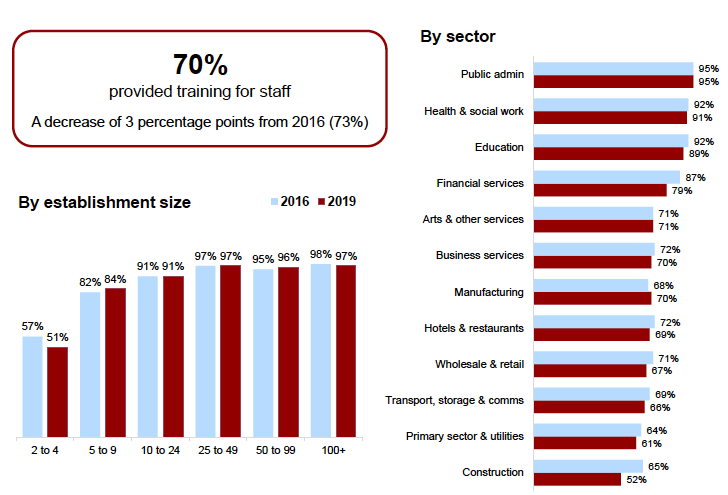
Base: All establishments: 2,652 (2019); 4,009 (2016)
For base by size and sector see Table A.1.1
By region, training provision was more common than average in the Edinburgh and Lothians (76%), this was particularly true for internal training (70%, compared to 60% average). Conversely employers in Lanarkshire were less likely than the overall average to have provided any training to staff (62%); again the difference was primarily seen in the provision of internal training (52%, compared to 60% overall).
Table 5.1 shows how training provision breaks down by internal and external sources by size and sector. The decrease in training provision has been focused on internal training, which has reduced from 63% of all employers to 60%. This decrease in internal training has not been focused on any one sizeband or sector; individual reductions do not reach statistical significance in any sub-group, but the cumulative effect amounts to a significant reduction overall.
Table 5.1: Training incidence and source by size and sector over time
| Unwtd Base (2016) | Unwtd Base (2019) | Any internal training | Any external training | Both internal and external training | Any training | ||||||
|---|---|---|---|---|---|---|---|---|---|---|---|
| 2016 | 2019 | 2016 | 2019 | 2016 | 2019 | 2016 | 2019 | ||||
| Scotland | 4,009 | 2,652 | % | 63 | 60 | 48 | 49 | 38 | 39 | 73 | 70 |
| Size | |||||||||||
| 2 to 4 | 1,004 | 643 | % | 45 | 40 | 33 | 32 | 21 | 21 | 57 | 51 |
| 5 to 9 | 983 | 608 | % | 71 | 73 | 52 | 55 | 41 | 45 | 82 | 84 |
| 10 to 24 | 905 | 619 | % | 84 | 84 | 67 | 69 | 60 | 62 | 91 | 91 |
| 25 to 49 | 519 | 364 | % | 93 | 89 | 81 | 82 | 77 | 75 | 97 | 97 |
| 50 to 99 | 289 | 161 | % | 93 | 91 | 83 | 85 | 80 | 80 | 95 | 96 |
| 100+ | 309 | 257 | % | 95 | 94 | 84 | 87 | 81 | 84 | 98 | 97 |
| Sector | |||||||||||
| Primary Sector & Utilities | 257 | 137 | % | 47 | 42 | 46 | 53 | 29 | 34 | 64 | 61 |
| Manufacturing | 187 | 160 | % | 60 | 64 | 44 | 45 | 37 | 39 | 68 | 70 |
| Construction | 252 | 162 | % | 51 | 35 | 48 | 37 | 34 | 20 | 65 | 52 |
| Wholesale & Retail | 847 | 525 | % | 63 | 60 | 39 | 40 | 31 | 32 | 71 | 67 |
| Hotels & Restaurants | 448 | 293 | % | 67 | 65 | 40 | 38 | 35 | 34 | 72 | 69 |
| Transport & Comms. | 233 | 170 | % | 58 | 60 | 41 | 43 | 31 | 37 | 69 | 66 |
| Financial Services | 91 | 91 | % | 81 | 72 | 44 | 53 | 38 | 46 | 87 | 79 |
| Business Services | 669 | 422 | % | 60 | 62 | 50 | 52 | 38 | 44 | 72 | 70 |
| Public Admin. | 109 | 76 | % | 86 | 92 | 70 | 61 | 61 | 58 | 95 | 95 |
| Education | 172 | 134 | % | 84 | 82 | 75 | 76 | 68 | 69 | 92 | 89 |
| Health & Social Work | 463 | 274 | % | 82 | 85 | 75 | 79 | 65 | 72 | 92 | 91 |
| Arts & Other | 281 | 208 | % | 62 | 57 | 48 | 49 | 39 | 35 | 71 | 71 |
Differences in the type of training provided can be seen by sector. Training employers in Primary Sector and Utilities were most likely to have provided external training (87%, compared to 70% of all training employers), and almost a third (32%) provided only external training (14% average). Training employers in Construction were also more likely than average to provide only external training (32%), although their overall use of external training was only marginally higher than average. Other high users of external training were training employers in Health and Social Work (86%), and Education (85%), these employers were likely to complement their external training with internal training (79% and 77% respectively had offered both).
Differences in the type of training were also seen by region, with training employers in Tayside most likely to have provided external training to staff (78%) and training employers in Forth Valley (94%), Ayrshire (92%) and Edinburgh and Lothians (also 92%) most likely to have supplied internal training.
Sources of external training
Use of public and private training providers
Training employers primarily use private training providers (as opposed to public providers) to deliver external training (see Figure 5.3); around two-thirds (65%) of used private providers, compared to two-fifths (19%) who used public providers. This is consistent with the figures seen in 2016. Just under one in six (16%) of training employers use both public and private providers to deliver their external training. Only a small minority (3%) solely relied on public providers to deliver their external training, whereas around half (49%) used solely private provision.
Figure 5.3: Sources of training by size and sector over time
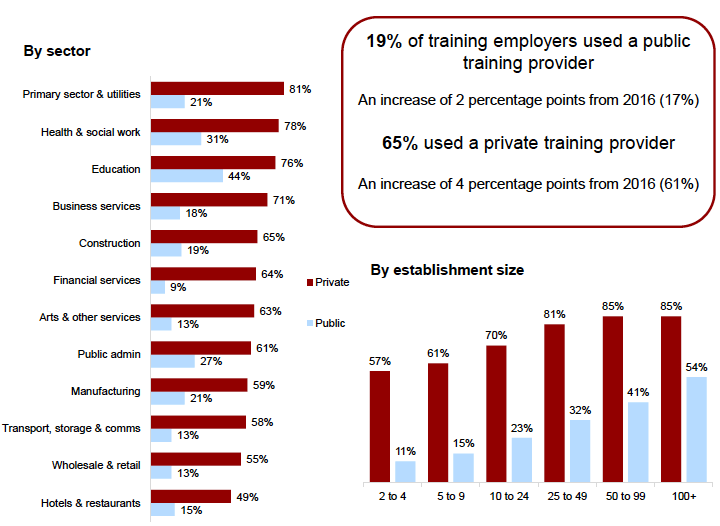
Base: all establishments providing training (2,167)
For base by size and sector see Table A.5.1
A minority of training employers with 2-4 staff used public training providers (11%), compared to over half (54%) of employers with 100 or more employees. The likelihood of using both public and private training providers increased with size, from 7% of those with 2-4 employees to 54% of those with 100 or more employees. Use of both public and private training providers increased across most sizebands between 2016 and 2019, however, the only significant increase was use of public training providers among employers with 10 to 24 employees (from 18% in 2016 to 23% in 2019).
There were considerable differences in the likelihood of employers using public training providers by sector. Training employers in the Education (44%), Health and Social Work (31%) and Public Administration (27%) sectors were most likely to use public training providers, and employers from Financial Services (9%) least likely to do so. The figures were again consistent with patterns seen in 2016.
This variation among employers may reflect the differing training requirements in different sectors, i.e. employers from Education, Health and Social Work and Public Administration are more likely to require employees to have the sort of formal qualifications (either vocational or academic) which tend to be delivered by public providers.
In terms of private provision, there were few significant changes among sectors from 2016. Training employers in the Primary Sector and Utilities (81% - up from 64% in 2016 ), Health and Social Work (78%) and Education (76%) were the most likely to use private training provision. Training employers in Health and Social Work and Education were also most likely to be using public providers, demonstrating the breadth of training needs in these sectors.
There were few significant differences by region, although employers in Edinburgh and Lothians were significantly less likely than average to have used any public training providers (12%, compared to 19% overall).
Specific training providers used by employers
A key aim of the EPS is to understand the specific types of provider(s) that employers use to upskill their workforce.
The types of providers employers used in 2019 have not changed significantly since 2016. Commercial training organisations[17] were again the most common type of training providers used, with over half (51%) of training employers using them for their training. Other providers used by training employers included: regulatory bodies (23%); suppliers (23%); and non-profit making organisations (15%).
Amongst all training employers 15% of employers used Colleges and 8% used Higher Education Institutions (HEIs) for training.
In terms of sector, employers from the Primary Sector and Utilities (61%), Health and Social Work (61%) and Education (61%) sectors were most likely to use commercial training organisations, whereas employers from the Financial Services (39%), Health and Social Work (33%), and Education (32%) sectors were more likely to turn to regulatory bodies.
Training employers in Financial Services (33%) were more likely to rely on suppliers[18] to provide training, this may reflect the fact that they are more likely to need specialist equipment or software (e.g. financial software).
There were a few differences by region. Training employers in the Borders were more likely than average to have used suppliers to deliver their training (34% compared with 23% nationally) whereas those in Highlands and Islands were less likely than average to have utilised this source of training (19%). There were few differences in the use of public sources, however training employers in Glasgow were more likely than elsewhere to have used HEIs to deliver training (13% vs. 8% average) whereas those in Edinburgh were less likely than elsewhere to have used Colleges (8%).
Vocational qualifications
This next section focuses specifically on the vocational qualifications[19] currently available and the extent to which they meet employer needs. This excludes apprenticeship qualifications, which are discussed in detail in the next chapter.
Take up of vocational qualifications
Despite a decrease in the proportion of employers offering training to their employees, the proportion of the population that had arranged or funded training designed to lead to a recognised vocational qualification in the last 12 months had increased to just under a third (31%, up from 26% in 2016). This equated to 44% of training employers, which was a significant increase of eight percentage points from 36% in 2016.
The proportion of training employers providing training designed to lead to a vocational qualification has increased across all sizebands, significantly so for those with 2-4 staff (from 23% to 34%) and 10-24 staff (from 44% to 55%).
By sector, Education remained the sector where training employers were most likely to have provided training to vocational qualifications (64%). However 2019 has seen significant increases in Construction (55%, up from 37%), Primary Sector and Utilities (48%, up from 32%), Transport, Storage and Communications (36%, up from 22%), Business Services (44%, up from 32%) and Wholesale and Retail (38%, up from 32%). Figure 5.4 shows the full breakdown by size and sector.
Figure 5.4: Employers training to Vocational Qualifications, 2019 and 2016
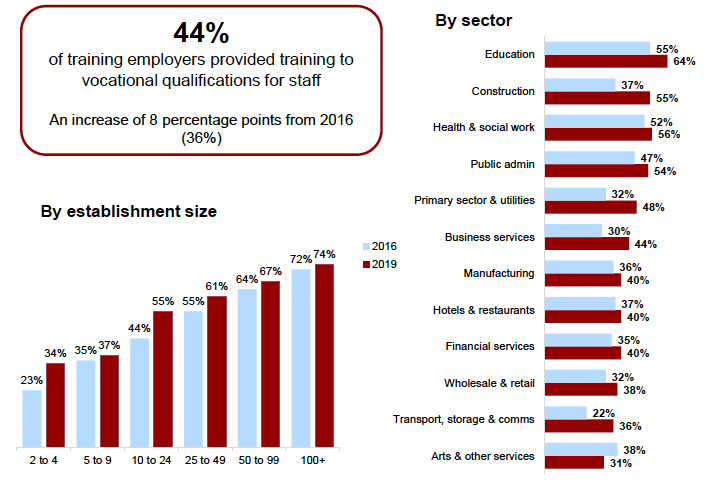
Base: all establishments providing training: 2,167 (2019); 3,288 (2016)
For base sizes by size and sector see A.5.1
Training employers in certain regions were more likely than others to provide training to vocational qualifications (see Figure 5.5). Most likely to were those in the Borders (56%), Forth Valley (50%),Tayside (48%) and Highlands and Islands (48%).
Indeed, at the overall level, training employers who had engaged with local DYW Leads or Regional Groups were more likely to provide vocational qualifications to staff than those who had not (59% vs. 45%).
Figure 5.5: Proportion of training towards vocational qualifications by region, 2019
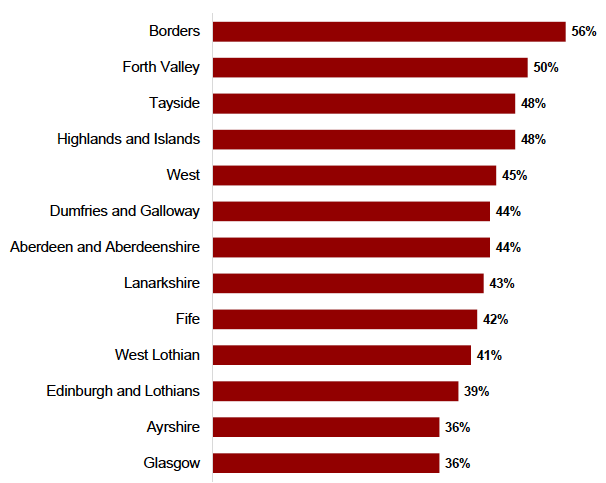
Base: all establishments providing training: 2,167 (2019)
For base sizes by region see Table A.5.1
Levels of vocational qualification provided
Employers who had arranged or funded training towards vocational qualifications for their staff in the last 12 months were most likely to have provided training towards vocational qualifications at the higher levels of the Scottish Credit and Qualifications Framework (SCQF), with 50% reporting they had trained staff to VQs at SCQF Level 6 or higher, compared with 32% to SCQF Level 5 or lower. The remainder did not know or gave an answer that could not be classified.
The 50% training to higher level qualifications was equal to that seen in 2016, however the 32% training to Level 5 or below was a decrease from 40% in 2016. The most common level of vocational qualification employers provided training for was SCQF Level 6 (30%); this was consistent with 2016.
Differences by size of employer reflected the propensity of larger employers to provide more training, with the proportion training staff to each level increasing with employer size.
Figure 5.6 shows the considerable differences in levels trained to by sector. Higher level qualifications (SCQF Level 6 and above) were most commonly provided by employers offering training to vocational qualifications in the Financial Services, Education and Health and Social Work sectors, and least often among Primary Sector and Utilities, Construction and Wholesale & Retail. Qualifications at SCQF Level 5 or lower were most common in the Public Admin and Health and Social Work sectors and least common in Business Services.
In some sectors, including Primary Sector and Utilities, Construction and Wholesale and Retail, employers were equally likely to offer training towards higher (SCQF Level 6+) and lower (SCQF Level 5 and below) level qualifications, illustrating the wide range of skill levels required in these sectors. For others, including Financial services, Education and Business Services, SCQF Level 6+ qualifications dominated their vocational qualification training offering.
Figure 5.6: Levels of vocational qualification employers offer training towards
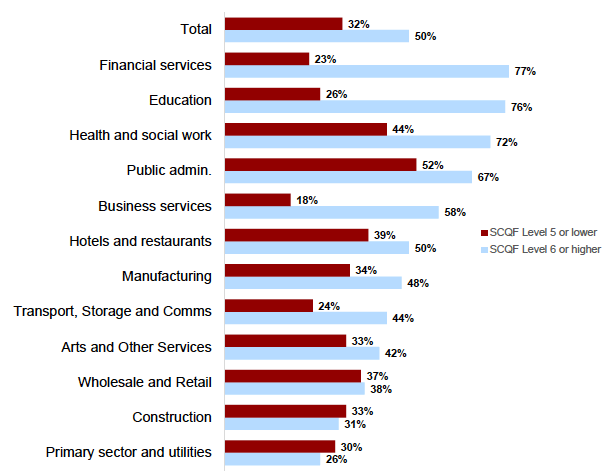
Base: all establishments providing training to vocational qualifications: 1,101
For base sizes by region see Table A.5.2
Perceived benefits of vocational qualifications
Employers that had arranged or funded training towards vocational qualifications in the last 12 months rated the extent to which they agreed vocational qualifications had provided certain benefits and impacts on their business and their staff. Figure 5.7 shows the breakdown of responses. The proportion of staff agreeing that vocational qualifications have helped staff retention has increased (from 76% to 80%) since 2016; overall levels of agreement for the other listed benefits have remained consistent since 2016.
Figure 5.7: Benefits and impacts of vocational qualifications
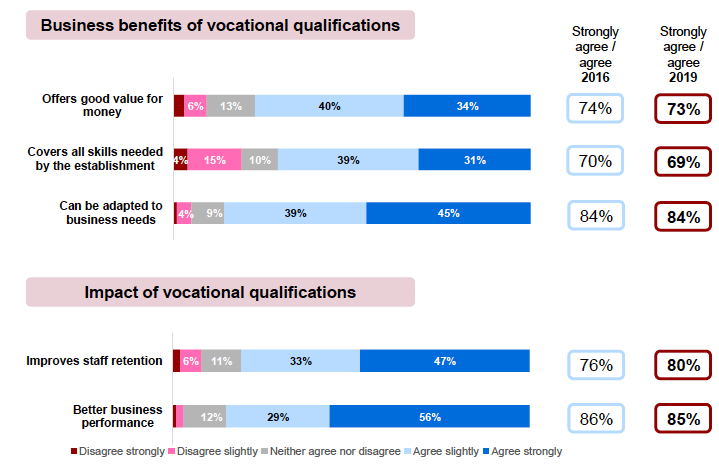
Base: all who have arranged training in the past 12 months that leads to vocational qualifications (1,101)
Employers offering training towards vocational qualifications were on the whole positive about the impact they had on their business. They were most likely to agree that vocational qualifications lead to better business performance and that they can be adapted to business needs. This is consistent with 2016.
Large employers, with 100 or more staff, were most likely to agree vocational qualifications lead to better business performance (91%), however employers in the Public Admin sector were much less likely to do so (72%).
Employers in Hotels and Restaurants sector were most likely to agree vocational qualifications can be adapted to business needs (90%).
Employers were less likely to agree that vocational qualifications cover all the skills needed by the establishment, indeed almost a fifth (19%) actively disagreed. Disagreement was significantly higher than average in the Manufacturing (30%) and Business Services (24%) sectors.
There were some other differences by sector. Employers in Construction were most likely to agree that vocational qualifications lead to better staff retention (89%), and those in Arts and Other Services were more likely to agree vocational qualifications offer good value for money (86%).
Small employers were less likely than larger employers to agree vocational qualifications offer good value for money. Among employers with 2-4 and 5-9 staff, 68% and 70% respectively agreed with this statement compared to 77-80% among the larger sizebands.
Barriers to greater take-up of vocational qualifications
Employers who had not arranged or funded training designed to lead to vocational qualifications in the 12 months preceding the survey were asked what the reasons were for not doing so.
The most common reason was a lack of knowledge with three in ten (31%) saying they did not know enough about what vocational qualifications were available. A similar number (28%) said their staff did not want vocational qualifications, and a fifth (21%) said they would need funding or grants from Government to consider doing so. The same proportion (20%) said they perceived vocational qualifications to be too complicated for their needs.
Figure 5.8 groups each of the reasons given into four categories: (a) Demand for vocational qualifications (from employers or employees); (b) issues around the Supply of vocational qualifications (for example, the delivery or format of the qualifications); (c) issues around financial Resources to deliver vocational qualifications; and (d) Information gaps as a barrier to take up.
Figure 5.8: Barriers to delivering vocational qualifications
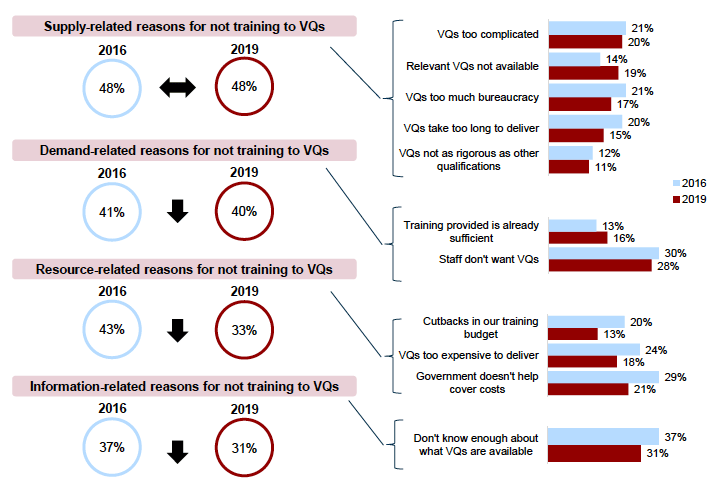
Base: all who have arranged training in the past 12 months that leads to vocational qualifications (2019: 1,066, 2016: 1,845)
This analysis demonstrates that the main barriers to greater take up of vocational qualifications are related to the supply of qualifications, with nearly half (48%) citing at least one issue with the vocational qualifications available that dissuades them from offering vocational qualifications to staff. Supply issues include that they are perceived to be: too complicated (21%); not relevant or available for all industries (19%); there is too much bureaucracy involved (17%); or that they take too long to deliver (15%). One in ten (11%) felt vocational qualifications were not as rigorous as other qualifications.
Four in ten employers (40%) not offering vocational qualifications to staff gave reasons relating to the demand for the qualifications. This was primarily from staff (28% said staff do not want vocational qualifications), but 16% also said they already offered sufficient training to staff.
Resources were mentioned by a third of employers (33%), including: 21% who said they did not offer vocational qualifications because the Government does not offer funding to help; 18% who said they were too expensive to deliver; and 13% who cited cutbacks in their training budgets. This was significantly fewer employers than in 2016, when 43% mentioned issues relating to the resource they had, and the decrease was seen across all three of the reasons feeding into this category.
The final category – lack of information – was mentioned by 31% of employers as being a barrier to them investing in vocational qualifications for staff. This is a notable decrease from 2016, when this was mentioned by 37% of employers.
There were a few differences by the sector the employer was operating in. Supply issues were most commonly reported in the Transport and Communications sector (60%), with 31% reporting that there were no vocational qualifications relevant to their industry. Employers in this sector were also more likely to cite financial reasons, with 44% giving a reason relating to the resources available for vocational qualifications.
Employers in the Education sector were also more likely than average to cite financial resource as a barrier (50%); this was driven by the 29% that said this was due to cutbacks in their training budget (compared to 13% average).
A lack of information about vocational qualifications was more commonly mentioned by employers in Wholesale and Retail (39%), and less likely than average to be cited as a reason by employers in Health and Social Work and Arts and Other Services (both 21%).
Employers in Financial Services were less likely than average to say supply issues were causing them a barrier (28%), and those in Manufacturing were less likely to be experiencing a lack of demand (27%).
There were not many differences by the employer’s region. Supply issues were more common than average in Tayside (60%), where employers commonly felt vocational qualifications were too complicated (29%) and too much bureaucracy (28%). Employers in the Highlands and Islands were less likely than average to say a lack of information prevented them from offering vocational qualifications (24%).
Information, advice and support
This section of the report aims to inform Scottish Government of the efficacy of current information channels and employers’ awareness and use of different providers and schemes of support.
Overall, around three in ten employers (29%) had experienced an issue that required advice, information or support on skills and/or training related issues in the 12 months preceding the survey. This was slightly lower than in 2016, when 33% experienced such a issue. Of those experiencing an issue, three-quarters (76%) had sought or received advice on the issue, leaving one quarter (24%) who had not.
Larger employers were more likely than smaller employers to have had a need for such support, with 22% of employers with 2-4 staff experiencing an issue rising to 58% of employers with 100 or more staff. When they did experience an issue, large employers were more likely than smaller employers to seek or receive advice (see Figure 5.9).
Figure 5.9: Employers seeking information, advice and other support on skills and training-related issues, 2019
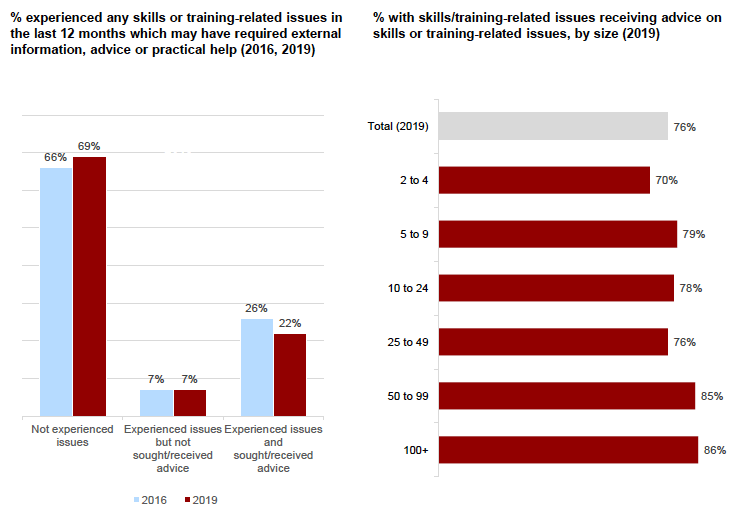
Base: all establishments: 2,652 (2019); 4,009 (2016) Base: all establishments with skills/training issues: 944. For bases by size see Table A.5.3
Employers in Education (55%) and Health and Social Work (40%) were more likely to have had a need for advice or information on training and skills related issues. However these were also the two sectors in which employers with a need were most likely to seek or receive such advice (91% and 87% respectively).
Conversely, employers in Wholesale and Retail were least likely to have a need (23%) but of those that did need advice or support just 59% sought or received any. In 2016 these employers were also less likely to have needed support (25% compared to 33% overall) but no less likely than average to have received it (79%, the same proportion as average). This suggests an issue for this sector in terms of the skills and training support available to them.
As in 2016, training providers were the most common source of support with 15% of all employers having received advice or information from each in the 12 months preceding the study. Around one in eight (14%) had used collectives and representatives (including professional/trade bodies, trade unions, other employers) and a similar proportion (12%) had used the public sector as a source of advice, including a Sector Skills Council (SSC) or other sector-specific body (5%), a local authority (4%), Skills Development Scotland (4%), Business Gateway (3%), Scottish Enterprise (2%), local DYW Lead or Regional Group (1%) and Highlands and Islands Enterprise (also 1%). Other private sources of advice were used by 3% of employers.
Figure 5.10: Sources of advice, information and support, 2019
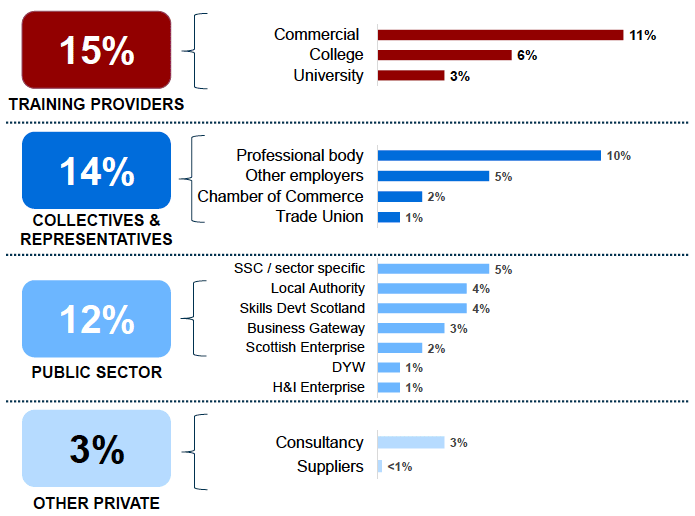
Base: all establishments: 2,652
Regional differences in public sector sources of advice were notable, particularly where the initiative has a regional focus. Employers in Forth Valley (17%) and Dumfries and Galloway (14%) were most likely to have used public sector sources of information, and the following differences were observed for specific initiatives:
- Employers in Lanarkshire were most likely to have turned to their Local Authority for advice (7%), and those in Edinburgh and Lothians least likely (2%);
- Employers in Glasgow were the most common users of Skills Development Scotland (7%);
- Business Gateway was most commonly a source of advice in the West (7%) and Lanarkshire (5%);
- 4% of employers in the Highlands and Islands had used Highlands and Islands Enterprise; and
- 5% of employers in Dumfries and Galloway and 2% in Highlands and Islands had used their DYW local Lead or Regional Group.
Related to their larger and more complex training needs, larger employers were more likely than smaller to have used every category of advice source. This difference was particularly notable relating to public sector sources of information, where employers with 100 or more staff were almost 10 times more likely to have used public sector sources of support than those with 2-4 staff (41% and 6% respectively).
Awareness and use of public sector initiatives
Employers were prompted as to their awareness and use of a series of initiatives set up or managed by Scottish Government, namely:
- Union Learning Fund[20];
- Flexible Training Opportunities;
- PACE (Partnership Action for Continuing Employment);[21] and
- The right of employees to request time to train.[22]
In total 19% of employers were aware of any of these initiatives, and 1% had used any. These figures varied widely by size of employer and, as Table 5.2 shows, 40% of employers with 100 or more staff were aware of at least one of the initiatives and 13% had used at least one.
Table 5.2: Awareness and use of specific Government initiatives, overall and by size
| All | 2 to 4 | 5 to 9 | 10 to 24 | 25 to 49 | 50 to 99 | 100+ | ||
|---|---|---|---|---|---|---|---|---|
| Unwtd Base | 2,652 | 643 | 608 | 619 | 364 | 161 | 257 | |
| % | % | % | % | % | % | % | ||
| Union Learning Fund | Aware | 2% | 1% | 2% | 3% | 3% | 4% | 12% |
| Used | <1% | <1% | 0% | 0% | 0% | 1% | 3% | |
| Flexible Training Opportunities | Aware | 10% | 8% | 12% | 12% | 13% | 15% | 13% |
| Used | 1% | 1% | <1% | 1% | 2% | 2% | 8% | |
| PACE | Aware | 10% | 8% | 10% | 13% | 17% | 18% | 26% |
| Used | <1% | <1% | <1% | 0% | 1% | 2% | 4% | |
| Right to train | Aware | <1% | 0% | 0% | 0% | 0% | 0% | 12% |
| Used | <1% | 0% | 0% | 0% | 0% | 0% | 4% | |
| Any | Aware | 19% | 15% | 20% | 22% | 27% | 32% | 40% |
| Used | 1% | 1% | 1% | 1% | 2% | 5% | 13% | |
Compared with 2016, awareness of the Union Learning Fund and Flexible Training Opportunities have seen significant decreases (from 4% to 2% for Union Learning Fund, and 13% to 10% for Flexible Training Opportunities). Conversely, awareness in PACE has increased, from 8% to 10%. These changes in awareness have not resulted in any changes to the propensity to use each initiative, however.
Employer collaboration
Employers working together to develop the skills or expertise of the workforce is something Scottish Government would like to encourage. This might include combining resources with other employers to fund a training course for staff at both/all participating organisations, providing training to (or receiving training from) staff from another employer, or working collaboratively to develop training policies and/or programmes for the employers’ specific industry or region.
Overall, just over one in seven (14%) of employers had collaborated with other employers in this way. This was in line with the figure seen in 2016. As Figure 4.12 shows, the propensity to work with other employers in this way increases with employer size, with 43% of the largest employers (100+ staff) having done so compared to just 8% of the smallest (2-4 staff).
Employer collaboration on training matters was much more common in the public sector (37%) and voluntary sector (30%) than in the private sector (11%). This is reflected in the sector breakdown in Figure 5.11, with sectors with a higher proportion of public and voluntary organisations (Public Admin, Education and Health and Social Work) showing much higher levels of collaboration.
Figure 5.11: Extent of employer collaboration to develop skills or expertise in the workforce, by size and sector
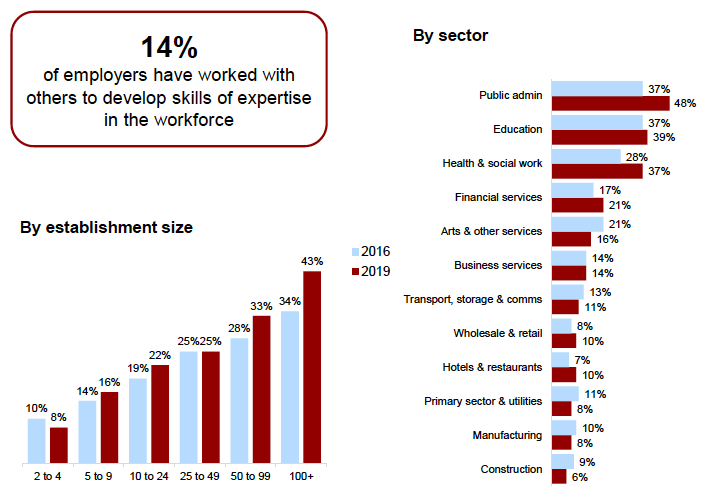
Base: all establishments (2,652)
For base sizes by size and sector see Table A.1.1
Collaboration was much more common among employers who had engaged with the local Developing the Young Workforce Lead or Regional Group, at 33%. The DYW Regional Groups promote such employer collaboration, suggesting that either they are effectively encouraging the collaboration or that the sorts of employers engaging with the Groups tend to be more collaborative anyway.
Involvement in the development and design of external training
This section looks at the extent to which employers who are engaging with external training providers are taking ownership of the content of this training, by making or taking the opportunity to tailor this training to their individual needs.
Developing the content of Vocational Qualifications
Overall 44% of employers who had provided training towards vocational qualifications for staff had had some level of involvement in determining the design or content of that training. Mainly this consisted of tailoring or developing the content of existing external training to make it suitable for their needs (33%), but 7% had devised the training content from scratch (4% had done both). This is slightly lower than in 2016 when 49% of employers training to vocational qualifications had been involved in the design of the training.
Employers with 100 or more staff were more likely to have been involved than smaller employers with 2-4 staff (58% compared to 36%). However, in 2016 employers with 50-99 staff were as likely as those with 100 or more staff to be involved; as illustrated in Figure 5.12 there has been a large reduction in 2019 in the proportion of employers in this sizeband (from 59% to 39%) involved in designing vocational qualification training.
Figure 5.12: Employers’ involvement in the design of training towards vocational qualifications
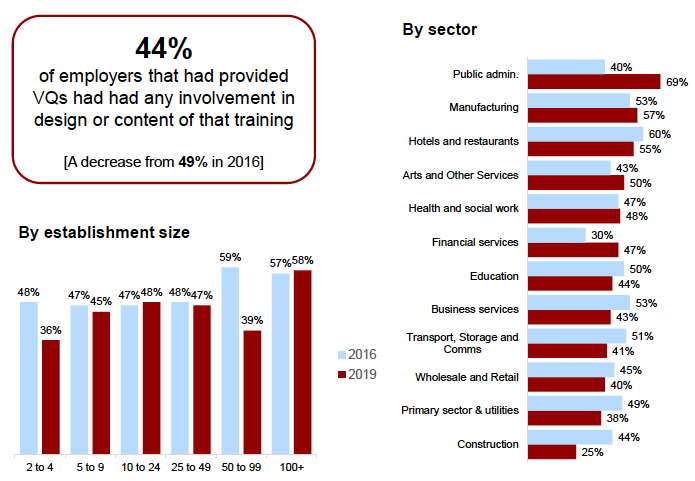
Base: all establishments that provide training to VQs (1,101)
For base sizes by size and sector see Table A.5.2
Employers in the Public Admin sector were significantly more likely than average to have had involvement in the design of vocational qualification training (69% vs 44% overall). In addition, the proportion of employers in the Public Admin sector involved in designing vocational training increased between 2016 to 2019 (from 40% to 69%). However, the size of this increase may not be as large as the data suggests due to low base sizes.
Employers in Manufacturing (57%) and Hotels and Restaurants (55%) were also more likely than average to be engaging in vocational qualification training design. Employers in Construction however were far less likely than average (25%) and less likely than in 2016 (44%) to be involved.
Employers who had had involvement in the design of vocational qualifications most commonly had worked with a training provider that was not a school, college or university to design and deliver this training (54%). A fifth (22%) had worked with a school or college and 7% with a university – both of these were more common among employers with 100 or more staff (41% and 17% respectively), and employers in Manufacturing were more likely than average to have used a school or college (41%).
A small number of employers who had been involved in vocational qualification design said they had worked with local DYW Leads or Regional Groups (3%), rising to 11% of employers with 100 or more staff, and 19% of those in the Education sector.
Other organisations involved included: industry specific organisations (3%); companies in the supply chain (3%); Government institutions (e.g. local authorities) (2%); and other non-profit making organisations (also 2%). A quarter (25%) said they did not work directly with other organisations to design vocational qualification training – this was particularly common among the smallest employers with 2-4 staff (34%).
Employers who had not been involved in the design or tailoring of the training content for vocational qualifications generally said they did not want to be involved (80%); however 18% said “yes” they would have liked to have been involved in this. This indicates a level of unmet demand for this sort of employer input into the design of training. This was more common among the largest employers (41% of those with 100 or more staff would like to have been more involved) and mid-sized employers (25% among those with 25-49 staff).
A third of employers (34%) that wanted involvement but did not get it said they did not know it was an option or were not given the opportunity. Other reasons given for not having the involvement they wanted included the time and effort required (22%), training providers who were uncooperative or unable to alter the content (18%) and not knowing how or who to approach (12%).
Developing the content of external training
Overall 39% of employers that had provided any external training to their staff had had any involvement in developing or tailoring the design or content of that training. This was slightly lower than the 43% seen in 2016. One in twenty (6%) had been involved in designing the training content from scratch, whereas 29% had tailored existing content to their needs (4% had done both).
As Figure 5.13 illustrates, the decrease has been mainly among smaller sized employers, in particular those with 10-24 staff which has seen a significant decrease from 48% to 39%. By sector, small declines were seen across the board with the exception of Financial services, where involvement has jumped from 37% to 67%. As with vocational qualification involvement, however, it is worth caveating the low base sizes involved.
Figure 5.13: Employers’ involvement in the design of external training
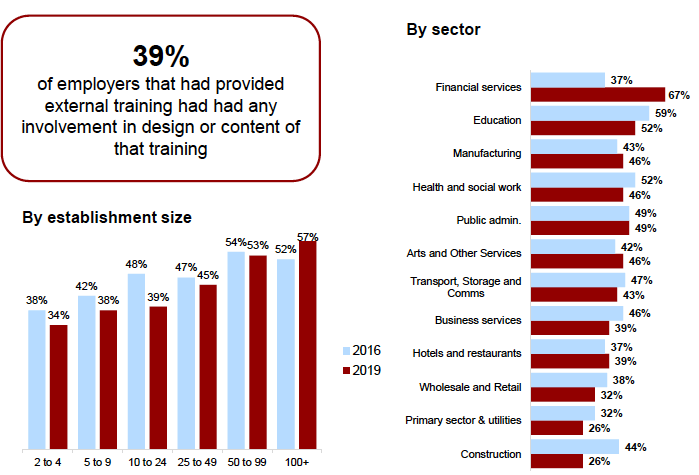
Base: all establishment that provide external training (1,635)
For base sizes by size and sector see Table A.5.4
Employers who had been involved in the design of external training had most commonly worked with a training provider other than a school, college or university (59%). Around one in six (17%) had worked with a school or college and 6% with a university.
Local DYW Leads or Regional Groups had been involved in 3% of cases; as with vocational qualifications this was particularly common among employers with 100 or more staff (14%) and employers in Education (17%).
Other organisations mentioned included Government institutions (e.g. Local Authorities), industry specific organisations and companies within the supply chain (all 4%), and other non-profit organisations (3%). A fifth (20%) said they had not worked directly with other organisations when designing the training.
Of those who were not involved in the design or tailoring of external training content, 17% indicated they would have liked more involvement. This was particularly common among mid sized organisations; 27% of employers with 25-49 staff and 28% of those with 50-99 staff would have liked more involvement.
The top three reasons for not having the involvement they would have liked were all mentioned by a similar proportion: 23% were not given the opportunity or did not know it was an option, 21% said it required too much time and effort, and 19% said the provider was uncooperative or unable to alter the content.
National Occupational Standards
National Occupational Standards (NOS) are developed by industry bodies and SSCs in conjunction with employers to benchmark the expected standard of performance of an individual in a particular workforce role, as well as the knowledge and understanding they need to enable them to meet that standard. They can be used to help employers plan training provision and benchmark whether their employees meet the expected standard.
Awareness of NOS has increased by four percentage points since 2016, from 40% to 44%. This brings it back up to the levels seen in 2012 (43%). One in twenty (5%) felt they had a “good” knowledge of NOS and what they involve, and 17% had “some” knowledge. The remaining 23% were aware of NOS but did not know what they were.
Figure 5.14: Awareness and use of National Occupational Standards (NOS), 2019
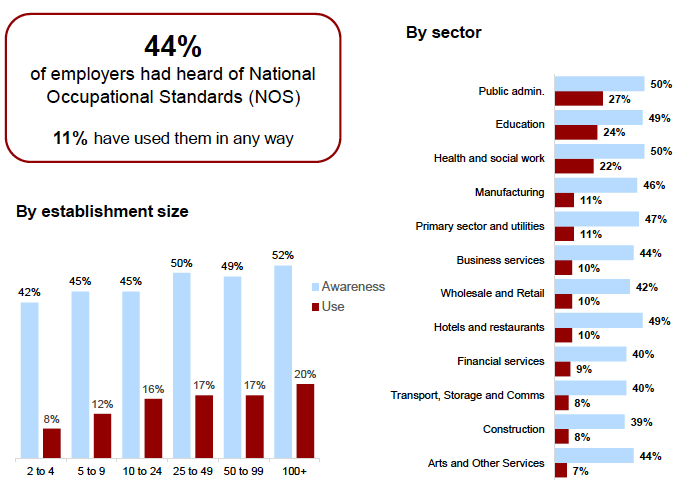
Base: all establishments (2,652)
For base sizes by size and sector see Table A.1.1
Figure 5.14 shows the breakdown in awareness and usage by size and sector. Awareness was higher among larger employers than smaller, however the biggest increase in awareness has been seen among the smallest employers (2-4 staff), where awareness has increased from 36% in 2016 to 42% in 2019.
By sector, there were no significant differences from the average in terms of overall awareness. However employers in Health and Social Work (32%) and Education (31%) were more likely than average (21%) to have any knowledge of what NOS are and what they involve.
Despite the increase in awareness, use of NOS remains unchanged from 2016 at 11% of all employers. Usage increased with employer size, and was more common among employers in the public sector (20%) and voluntary sector (15%). Reflecting this, the sectors showing the highest usage of NOS were Public Admin (27%), Education (24%) and Health and Social Work (22%).
Most commonly employers had used NOS to: develop training plans (8%); for performance management and staff appraisals (7%); to develop job descriptions or guide recruitment (6%); and for succession planning or competency frameworks (6%). This is consistent with usage patterns in 2016.
Contact
Email: peter.phillips@gov.scot
There is a problem
Thanks for your feedback